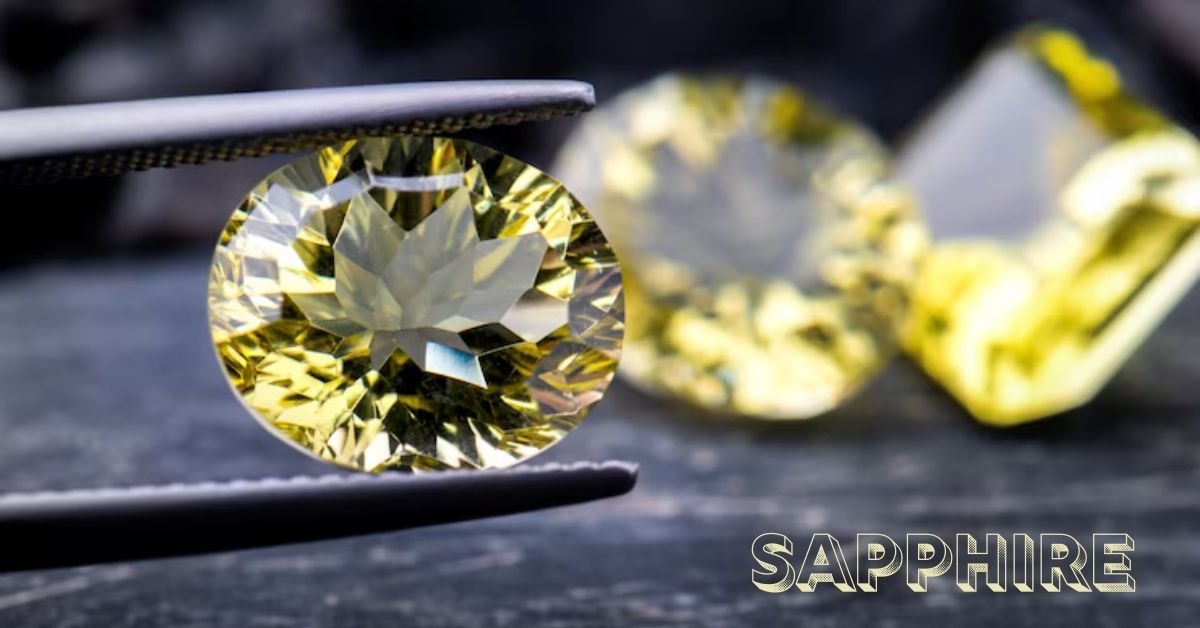Sapphires are one of the most sought-after gemstones in the world, known for their breathtaking beauty and incredible durability. But what exactly makes sapphires so special? In this article, we’ll delve deep into the world of sapphires, covering their types, characteristics, mining sources, and their significance in jewelry. Whether you’re a gemstone enthusiast or considering a sapphire for your next piece of jewelry, this guide will provide you with all the information you need.
What is Sapphire?
Sapphire is a precious gemstone that belongs to the corundum family. The corundum family also includes rubies; the only difference is the color. While rubies are red, sapphires come in a variety of colors, most famously blue. The term “sapphire” is derived from the Latin word “sapphirus” and the Greek word “sappheiros,” both of which mean “blue stone.” Sapphires have been cherished for centuries, symbolizing wisdom, virtue, and good fortune.
Types of Sapphires
Sapphires come in two main types: natural and synthetic.
Natural Sapphires
Natural sapphires are formed under intense heat and pressure within the Earth’s crust over millions of years. The most famous natural sapphires are blue, but they can also be found in yellow, pink, green, and even colorless varieties. These sapphires are highly valued for their rarity and unique color characteristics.
Synthetic Sapphires
Synthetic sapphires are created in a laboratory using processes that replicate the natural conditions under which sapphires form. While they have the same chemical composition as natural sapphires, they are generally less expensive. Lab-created sapphires are an excellent option for those who want the beauty of a sapphire without the high cost.
Characteristics of Sapphires
Sapphires are renowned for their stunning color, exceptional hardness, and brilliance.
Color and Clarity
The most prized sapphires are those with vivid, saturated colors. Blue sapphires are particularly valued for their deep, rich hues, but sapphires can also be found in shades of yellow, pink, green, and purple. Clarity is another important factor, with the best sapphires being free of inclusions and blemishes.
Hardness and Durability
Sapphires are incredibly durable, ranking 9 on the Mohs scale of hardness. This makes them suitable for everyday wear, as they are resistant to scratches and chipping. Their hardness also contributes to their brilliance, as sapphires can be cut and polished to a high degree of precision.
Cut and Shape
The cut of a sapphire significantly affects its overall appearance. Common shapes include round, oval, cushion, and emerald cuts. A well-cut sapphire will reflect light beautifully, enhancing its natural color and brilliance. The choice of cut often depends on the color and clarity of the stone, as well as personal preference.
Sapphire Mining and Sources
Sapphires are mined in several countries around the world, each producing stones with unique characteristics.
Major Sapphire Producing Countries
Sri Lanka, also known as Ceylon, is famous for its high-quality blue sapphires. Myanmar (formerly Burma) is another significant source, known for producing sapphires with exceptional color and clarity. Madagascar has emerged as a leading producer in recent years, offering a wide range of colors. Australia is also notable for its sapphire production, particularly dark blue and green sapphires.
Ethical Considerations in Sapphire Mining
Ethical sourcing is an important consideration when purchasing sapphires. Many buyers are concerned about the environmental and social impacts of mining. Look for certifications and assurances that the sapphires you purchase are ethically sourced, supporting fair labor practices and environmental sustainability.
Sapphire in Jewelry
Sapphires are a popular choice for a variety of jewelry styles, from engagement rings to necklaces.
Popular Jewelry Styles
Sapphire engagement rings are a timeless choice, often favored for their symbolism of loyalty and trust. Necklaces, bracelets, and earrings featuring sapphires are also highly sought after, adding a touch of elegance and sophistication to any outfit.
How to Choose a Sapphire for Jewelry
When selecting a sapphire for jewelry, consider factors such as color, clarity, cut, and carat weight. The most desirable sapphires have a rich, vivid color, excellent clarity, and a well-proportioned cut. It’s also important to consider the setting, as this can greatly enhance the stone’s appearance.
The Significance of Sapphire
Sapphires have held cultural and historical significance for centuries.
Historical and Cultural Importance
Throughout history, sapphires have been associated with royalty and nobility. They were believed to protect their wearers from envy and harm, as well as to attract divine favor. Many ancient cultures, including the Greeks and Romans, prized sapphires for their protective and healing properties.
Symbolism and Meaning
In addition to their historical significance, sapphires are rich in symbolism. They are often associated with wisdom, virtue, and good fortune. Blue sapphires, in particular, are thought to symbolize loyalty, trust, and truth, making them a popular choice for engagement rings and other meaningful jewelry.
Caring for Sapphires
Proper care is essential to maintain the beauty and longevity of sapphire jewelry.
Cleaning and Maintenance
To clean sapphire jewelry, use a mild soap solution and a soft brush to gently remove dirt and oils. Avoid harsh chemicals or abrasive cleaners, as these can damage the stone and its setting. Regular cleaning will keep your sapphires looking their best.
Storing Sapphires Safely
When not wearing your sapphire jewelry, store it in a soft pouch or a lined jewelry box to prevent scratches and other damage. It’s best to store each piece separately to avoid contact with other jewelry that could cause abrasions.
Investing in Sapphires
Sapphires can be a valuable investment, provided you know what to look for.
Market Trends and Value
The value of sapphires can vary widely based on factors such as color, clarity, and origin. Blue sapphires from renowned sources like Sri Lanka and Myanmar tend to command higher prices. Keep an eye on market trends and seek advice from reputable gemologists when considering sapphire investments.
How to Evaluate Sapphire Investments
When evaluating sapphires as an investment, consider the stone’s color, clarity, cut, and carat weight. Additionally, ensure that the sapphire is accompanied by certification from a recognized gemological laboratory. This documentation provides assurance of the stone’s authenticity and quality.
Conclusion
Sapphires are not only stunning gemstones but also hold a rich history and cultural significance. Whether you’re looking to purchase sapphire jewelry or invest in these precious stones, understanding their types, characteristics, and ethical considerations is essential. With proper care, your sapphires will remain beautiful and valuable for generations to come.
FAQs
What is the most valuable color of sapphire?
The most valuable color of sapphire is a deep, vivid blue known as “cornflower blue.” These sapphires are highly prized for their intense color and rarity.
How can you tell if a sapphire is real or synthetic?
A real sapphire will have natural inclusions and imperfections, whereas synthetic sapphires are typically flawless. Professional gemologists can use advanced tools to determine the authenticity of a sapphire.
Are sapphires suitable for daily wear?
Yes, sapphires are suitable for daily wear due to their hardness and durability. They are resistant to scratches and can withstand everyday activities.
What are the best ways to clean sapphire jewelry?
The best way to clean sapphire jewelry is with a mild soap solution and a soft brush. Avoid using harsh chemicals or abrasive materials that could damage the stone or its setting.
How do sapphire investments compare to other gemstones?
Sapphire investments can be quite valuable, especially for high-quality stones from renowned sources. Compared to other gemstones, sapphires tend to hold their value well and are highly sought after in the market.











